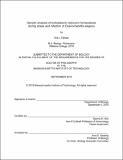Genetic analysis of endoplasmic reticulum homeostasis during stress and infection of Caenorhabditis elegans
Author(s)
Tillman, Erik J. (Erik James)
DownloadFull printable version (14.92Mb)
Other Contributors
Massachusetts Institute of Technology. Department of Biology.
Advisor
Dennis H. Kim.
Terms of use
Metadata
Show full item recordAbstract
Animals experience intrinsic and extrinsic stressors throughout development and adulthood. To maintain cellular and organismal homeostasis, eukaryota and metazoa rely on conserved, integrated stress response pathways. Throughout its life cycle, the free-living nematode Caenorhabditis elegans encounters diverse microbial taxa, including both nutritional and pathogenic species. Intestinal infection with the pathogenic bacteria Pseudomonas aeruginosa induces a transcriptional innate immune response leading to the secretion of immune effector molecules into the intestinal lumen. Previous work has demonstrated a critical role for the endoplasmic reticulum unfolded protein response in surviving immune activation during larval development. Specifically, the most ancient IRE-1/XBP-1 branch of the UPR is required for larval development during immune activation, whether or not pathogen is present. To understand additional mechanisms regulating ER homeostasis in C. elegans, we conducted a forward genetic screen and identified suppressors of xbp-1 mutant larval lethality on P. aeruginosa. In this work, I outline the characterization of several identified mutations that each affect a gene encoding a broadly conserved transcriptional regulator. A mutation in the gene encoding the forkhead DNA binding domain-containing transcription factor FKH-9 enhances ER homeostasis outside the context of infection and immune activation, but paradoxically sensitizes animals to perturbations in cytosolic proteostasis. My results suggest that loss of fkh-9 enhances translocation of misfolded proteins out of the ER, thereby disrupting cytosolic proteostasis and decreasing proteasomal function. These findings implicate a critical need for balancing proteostasis across cellular compartments during organismal stress, and further investigation of the additional characterized mutants will elucidate the breadth of this phenomenon.
Description
Thesis: Ph. D., Massachusetts Institute of Technology, Department of Biology, 2018. This electronic version was submitted by the student author. The certified thesis is available in the Institute Archives and Special Collections. Cataloged from student-submitted PDF version of thesis. Includes bibliographical references.
Date issued
2018Department
Massachusetts Institute of Technology. Department of BiologyPublisher
Massachusetts Institute of Technology
Keywords
Biology.